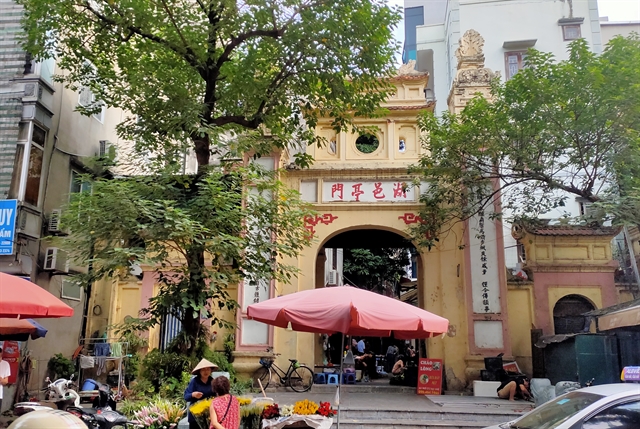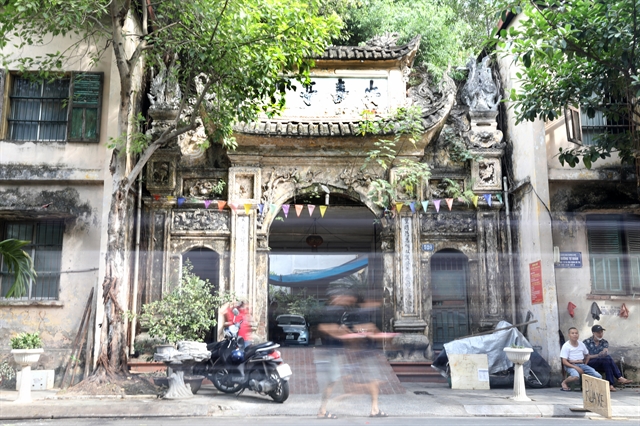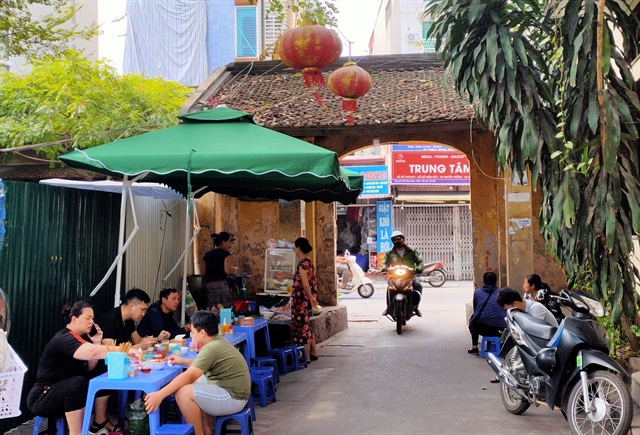Weather:
- Ha Noi 22oC
- Da Nang 20oC
- Ho Chi Minh 28oC

By Thanh Nga
Visiting Thụy Khuê Street on a crisp fall morning in Hà Nội, one can't help but be captivated by the ancient allure emanating from the centuries-old village gates. These gates, steeped in Vietnamese culture, possess a magnetic quality that compels travellers to pause and reflect.
Thụy Khuê boasts a collection of nearly a dozen village gates, standing as testaments to the generations that have passed. Once tranquil villages encompassing the Thăng Long Citadel, these gates have withstood the test of time. While the cultural customs and activities of the people have changed over the course of Thăng Long – Hà Nội 's 1,000-year history, these village gates continue to be cherished by locals as precious treasures, even amidst a bustling thoroughfare.
The village gates are found in their greatest concentration at the end of Thụy Khuê Street. People still gather here regularly, conducting business, leaning against the gates, and exchanging light-hearted banter to alleviate the weariness of daily life. Gradually, these village gates have transformed into pillars of support, fostering closer connections among the community.
At first glance, the village gates exude an air of both unfamiliarity and familiarity. However, each walk through these gates evokes a sense of excitement. Every gate serves as a custodian of cultural heritage, with weathered walls adorned with intricately carved details, remnants of a bygone era.
Every ten meters along the street, one encounters a moss-covered traditional gate, its towering presence accompanied by a pair of parallel sentences inscribed in elegant Chinese characters, extending a warm welcome to visitors. Each gate possesses its own unique size and architectural style. Notably, the majority of these gates stand on the side facing West Lake, where ancient villages once thrived.

Arranged sequentially along today's Thụy Khuê Street, these villages include Yên Thái, An Thọ, Đông Xã, Hồ Khẩu and Thụy Khuê. Among them, Yên Thái village gate, located at No 562 Thụy Khuê, resembles a grand house. This village is renowned for its production of "dó" paper, which was historically supplied to the royal court.
Adorning the village gate is a horizontal lacquered board inscribed with the words "Mỹ tục khả phong" (Fine customs are bestowed), a tribute from the Nguyễn Dynasty to the village. Adjacent to it stands a commemorative plaque marking the visit of late President Hồ Chí Minh in 1946.
Yên Thái Village stands out as one of the most remarkable settlements along Thụy Khuê. It has managed to preserve its ancient charm, with walls constructed from red bricks arranged in a distinctive coconut leaf pattern. Notably, despite numerous excavations for electricity and water system renovations, the villagers have gone to great lengths to protect the original state of the road, which has endured for over a century.
Beyond each village gate, extending into the street, lie the alley gates. Stepping into Yên Thái Village, one is greeted by a multitude of these alley gates. Although smaller in size compared to the village gates, they still serve as demarcations, delineating the boundaries between different hamlets.

The people of Yên Thái Village take great pride in their ancient village gates, and they have fascinating stories to share about these historical landmarks.
"In the past, all village gates were equipped with ironwood wings. These gates were only opened during the day and securely closed at night to ensure the security and order of the entire village. As a young man, I often found myself climbing over the gate and crawling through alleys to enter the village because I would come home late after being out," Nguyễn Văn Phú recalled.
"Not only me, but everyone here feels a deep sense of pride being from Yên Thái and an even greater pride in our thousand-year-old village gates. It's just a pity that the gates are no longer intact due to the passage of time," Phú said.
Next in the sequence along the street is An Thọ Village, which comprises three gates: the An Thọ communal house gate, the Hầu gate, and the Xanh (Green) gate.
The Green Gate stands at the entrance of Alley No 514 on Thụy Khuê Street. Historically, this gate served as a defence against intruders, earning it the name Canh (Guarding) gate. However, it has now transformed into the Green gate.

Đông Xã village gate, located at Alley No 444 on Thụy Khuê Street, once had five steps leading up and down. However, as time passed, these steps were levelled to facilitate easier movement. The gate still retains the characteristics of an ancient village, adorned with parallel sentences on both sides.
Just 20m away lies the Đông Xã Communal House, with the ancient Mật Dụng Pagoda and the communal house yard serving as the inner entrance.
Hồ Khẩu Village boasts three large and sturdy gates. In the past, the main gate of the village would only be opened during festivals or important occasions. Nowadays, it has become a marketplace for the locals. Over time, the side gates of the village have been made flat to accommodate motorbike traffic, but the main gate still retains its steps, preserving the characteristic cultural features while allowing pedestrians to traverse.

Despite numerous changes brought about by urbanisation and modernisation, much about the lifestyle behind these gates remains unchanged for hundreds of years - simple and peaceful. Behind these gates, small markets open every morning, providing a gathering place for people to enjoy tea, children to play, and elders to engage in chess games.
Thụy Khuê Street, in addition to its unique village gates, also boasts several ancient temples and famous relics such as Đồng Cổ Temple dating back to the Lý Dynasty, An Thái Communal House, and Đông Xã Communal House. These sites have all been classified as national historical relics, adding a distinct beauty to Thụy Khuê that cannot be found on any other street in Hà Nội. VNS


